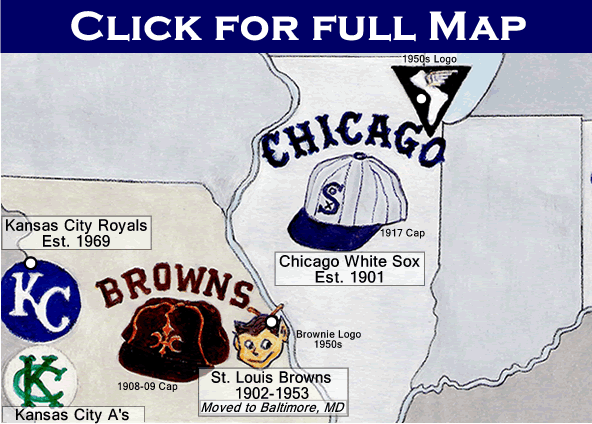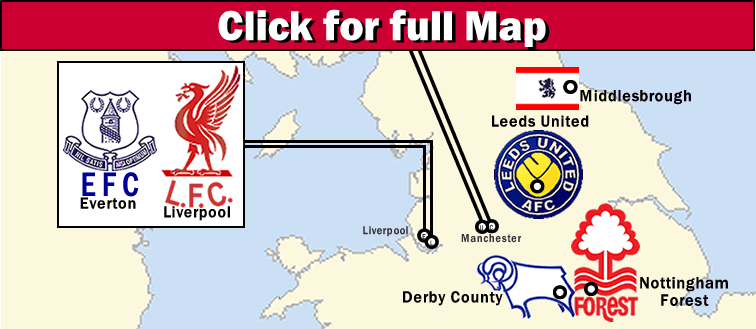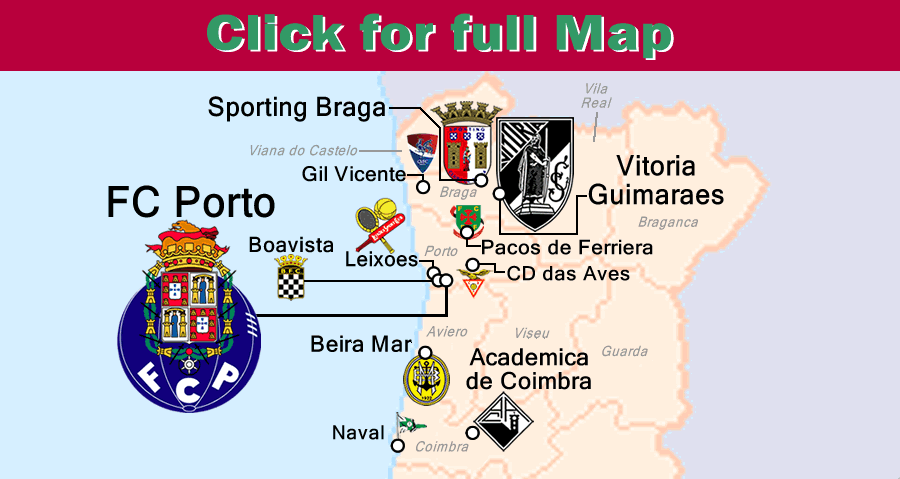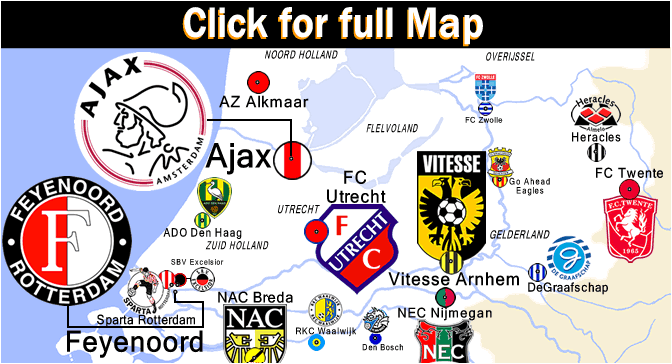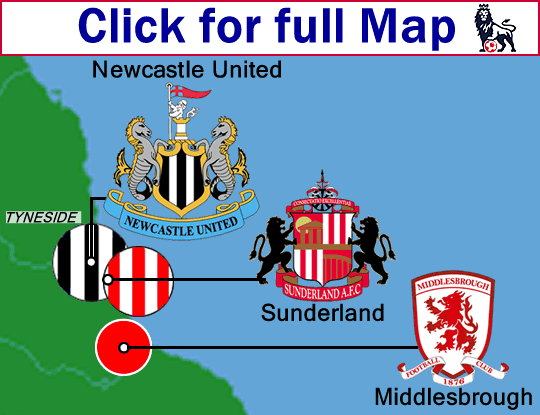
English Premier League attendance is up 5 % this season, but some of that can be explained by the addition of Sunderland. The Black Cats have rocketed to the 5th best attendance in the country. They are up 10,000 from last season’s final totals (when they won the 2nd Division). As for the two other newly promoted clubs, Derby has an increase of 6,200, while Birmingham’s gate is up 4,100. The 2 biggest gate increases of non-promoted clubs are at Aston Villa and Manchester City. Both these clubs are seeing a rejuvenation on the field, and it has been reflected in the turnstiles. Villa are 3,000 above last season’s average; City shows an increase of 1,600. The club with the biggest downturn is Bolton, at -2,000. They seem doomed to relegation, and it looks like the fans know it.
October 28, 2007
English Premier League, October 2007 attendance update.
October 26, 2007
Hockey of the North Atlantic, circa 1994.
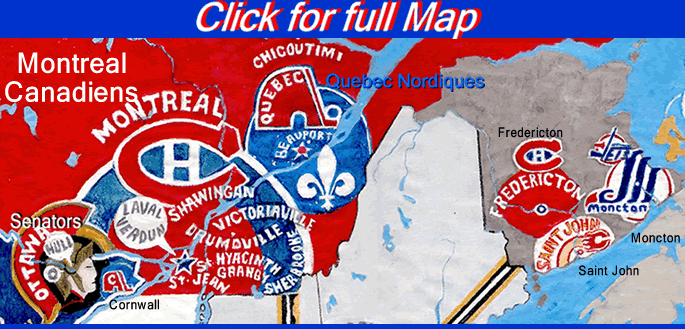
This is a map from my early days of sports maps, around 13 years ago. As you can see, I was way more into the unbridled use of color and form, and less into accuracy. I can remember, halfway into the map, deciding to put in minor-league hockey clubs, only to realize (pre-internet) that I had little chance of finding the logos for most of these small clubs. So I improvised: Ontario Hockey League trading cards I had helped; and for the Quebec Major Junior Hockey League teams, I just used their names alone. This map has teams from the National Hockey League; the American Hockey League; the aforementioned OHL and QMJHL; and the East Coast Hockey League. Minor league affiliations of AHL clubs are noted by small logos of their parent NHL clubs. The player in the map’s legend is New York Ranger goalie Mike Richter, in his 1994 All-Star team uniform.
October 24, 2007
1979: The North American Soccer League.
…
This map shows the 1979 North American Soccer League, whose heyday was in the late 1970s. The league averaged 13,084 in 1979, and hit its high of 14,201 the following year. The league is most famous for the New York Cosmos and their star-studded roster, but the Vancouver Whitecaps were champions in 1979. The Cosmos had won it in 1977 and 1978, and won it again in 1980. The Cosmos rise (and subsequent fall) was meteoric, to say the least. Before they signed Pele, in 1977, they were playing in a rundown stadium on Randalls Island, drawing 5,000 at best. In the short span of four years, 1974 to 1978, the Cosmos’ average gate went from 3,578 to 47,856.
In 1979 the Cosmos averaged 46,690. That same season, Tampa Bay, Minnesota, and Vancouver all drew very well, between 22,000 and 27,000. Seattle, and somewhat surprisingly, Tulsa, were drawing respectable crowds in the 16,000-18,000 range. San Jose drew 15,000; Los Angeles, though fielding Johann Cruyff, only drew 14,000. Also, Chicago averaged only 8,000, a poor showing considering the size of the city and the fact that the team was competitive. In retrospect, that last attendance figure could be seen as the writing on the wall. For if a decent team, in a huge city, in middle America, couldn’t pull 10,000 through the turnstiles, then the viability of the whole project was in doubt. Especially with the high salaries of the overseas players.
Growing up in Rochester, New York, I was a devout follower of the Rochester Lancers. Opposing players dreaded the barracks-like atmosphere of their crumbling concrete stadium and its potato patch field. This gave the scrappy, Slavic-heavy Lancers squad a solid home advantage. Before game time, me and my brothers would go up to the top of the stadium and watch the traffic pulling in, trying to will more fans through the turnstiles. In 1979, Rochester had its best gate, 8,600. But it wasn’t enough to keep them alive, and after the 1980 season, the Rochester Lancers of the NASL dissolved. The NASL was dead to me at that point. It died for real, 4 years later. It had existed from 1968 to 1984. Its most vibrant period was from around 1976 to 1981. Pele, Eusebio, Rodney Marsh, George Best, Franz Beckenbauer, Bobby Moore, Giorgio Chinaglia, Trevor Francis, Carlos Alberto, and many more world football legends graced the rosters of NASL teams. The stodgy rules of the game were relaxed, with a striker-friendly 35-yard offside line, and shootouts instead of penalty kicks. The shootouts were awesome. It was a 5-second-Chinese-fire-drill, with the goal keeper usually rushing towards the shooter. The shooter then had to decide whether to elude the keeper, rifle the ball low, or chip it. Offense was further encouraged by awarding points in the standings for goals scored. So even if you lost, you could gets points in the standings.
But the league over-expanded, diluting on-field quality. The league expanded from 16 to 24 teams in 1977, and many franchises shifted to other cities. The clueless new ownership of many franchises aped the Cosmos, overspending on aging internationals and letting domestic talent languish on the bench. When the crowds fell off, the owners bolted. Some also believe that when FIFA awarded the 1986 World Cup to Mexico, instead of the US, it hastened the league’s demise. Still, the NASL ultimately contributed to the overall improvement of the quality of American (and Canadian) players, and their national teams. The US national team has been transformed from also-rans to a competitive force. And no American ever played in the English 1st Division before the NASL. John Harkes was the first, with Sheffield Wednesday, in 1990. Today, the USA is represented in England by the likes of Brian McBride, Clint Dempsey, Carlos Bocanegra, and Kasey Keller on Fulham; Marcus Hanhnemann and Bobby Convey on Reading; Brad Friedel on Blackburn; Tim Howard on Everton; Jonathon Spector on West Ham United, and Jay Demerit on Watford.
October 22, 2007
The American League, established 1901.
…
The World Series starts Wednseday, so this is a good time for a baseball map. This map was drawn in 2005. The map includes every ball club that has played in the American League, since its inception in 1901. The American League was created 25 years after the National League, which was formed in 1876. Since 1903, the winner of each league has gone on to play in the best-of-7-game World Series. Featured on this map are caps, logos, and cap crests from the past, with the years listed. Franchise shifts are also noted.
October 19, 2007
UEFA Cup Group Stage, 2007-08.

Franz Beckenbauer once called the UEFA Cup the “Losers Cup.” But now, as president of Bayern Munich, he must watch his team compete in it. Bayern’s average gate dwarfs much of the competition; Germany has the top 3 here. There are some decent numbers from clubs like FC Copenhagen, FC Basel, and Zenit St. Petersburg, all drawing in the low 20,000s. The UEFA Cup may be the second-tier cup of Europe, but there are still solid attendance figures for most of the clubs involved.
October 16, 2007
1977-78, England. Nottingham Forest, champions.
…
-
Click the icon to the right for just the kits and crests of the 22 clubs.
…
Click the title to the right for just the map. 1977_map3.gif
I needed to do a good deal of research for this map and chart. Here is a list of sites I utilized….
1. Historical Football Kits www.historicalkits.co.uk. The kits I used are from this site. Check it out. It rules. 2. Behind the Badges www.behindthebadges.co.uk Origins of football club badges. 3. Footy-mad sites www.footymad.net. They have sites for all 92 clubs in the English League. I go to the Portsmouth site every few days (www.portsmouth-mad.co.uk). Great reporting and commentary. Plus, they have the League history of each club. I used this for the relegations/promotions part of the chart. 4. Classic Kits www.kitclassics.co.uk. They feature away kits, too. 5. European Football Statistics www.european-football-statistics.co.uk. This is where I get my attendance figures. 6. I can’t seem to link this next one , so google ”Nigel’s webspace” if you like old cards and magazines. Where I found the old Forest pennant. 7. Sykes Online www.sykesonline.com. Where I found the Leeds smiley badge, a design that really belongs on some 1970s prog-rock album cover. 8. Martin’s Coventry City Page www.martinwildig.com. 9. Pride of Anglia www.tmwmtt.com. Ipswich Town site. 10. Bristol City Supporter’s Trust www.bristolcityst.org.uk. 10. Nottingham Forest FC www.nottinghamforest.premiumtv.co.uk. 11. BBC www.bbc.co.uk. 12. Wikipedia www.en.wikipedia.org. 13. E-Bay www.ebay.com. 14. Russell Davies www.russelldavies.typepad.com/planning/2004/09/. His eulogy for Brian Clough.
October 12, 2007
Portugal. Attendance map, 2006-07.
The big 3 in Portugal is Benfica (31 titles), Porto (22 titles), and Sporting Club Portugal [aka Sporting Lisbon] (18 titles). They have won all but 2 league titles. Belenenses won the league in 1946 , and Boavista won it in 2001.
Portugal’s domestic league is good enough to get them up to 3 spots each year in the Champions League. Portugal’s current national league ranking by UEFA is #6 in Europe.
October 8, 2007
The Netherlands. Attendance map, 2006-07.
[Note: to see my latest post on the Netherlands, click here.]
The Dutch are so good at football that it’s often forgotten how small a country the Netherlands is. But they weren’t always a force. Before the Johann Cruyff-led ”total football” squads of the early 70′s, they had trouble beating even lowly Luxembourg (ca. 1964). The Dutch top flight is called the Eredivisie. The league has 18 teams, and the bottom half is a revolving door of minnow clubs. But there are some good-sized clubs just below the big 3 of Ajax, PSV, and Feyenoord. Heerenveen has seen their average gate grow from 13, 700 in 1999; to 25,4oo last season. They are a perennial fixture in the UEFA Cup, and did manage to make it to the Champions League in 2000. Utrecht is the only club outside the big 3 that have never been relegated. They have increased their gate from 7,500 to 20,000 in a decade. Vitesse has been drawing crowds in the low 20,000′s for over a decade. Groningen averaged 19,000 last season, in their new stadium. AZ Alkmaar’s new stadium upped their attendance to almost 16,000. They had been playing in an 8,400-seat stadium before.
October 5, 2007
The Netherlands. Football Clubs 2006-07.
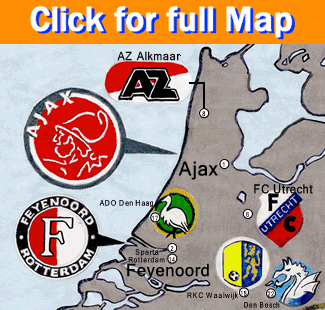
I made this map in the fall of 2004. I updated it by adding promoted clubs, and some 2nd division clubs, so that the map shows the 23 highest drawing clubs from last season. It isn’t an Attendance map, however, as the team crests aren’t proportionally sized. PSV won the title last season, on the last game, on goal difference. AZ Alkmaar blew it, basically, and their attempts to break into the top echelon of Dutch clubs (the big 3) was put on hold for another season. The big 3 is Ajax (29 titles), PSV Eindhoven (20 titles), and Feyenoord (14 titles). Since 1965, no other team has won the Eredivisie title, except for AZ in 1981. AZ just moved into a new 17,000 seat stadium, with plans to expand it later.
October 3, 2007
Ukrainian football clubs (hand-drawn map circa 2003).

…
…
In January 2004, I was all “mapped out” in terms of US sports. My brother was into the Premier League (an Arsenal fan), and I decided to try doing a map of English football. Suffice to say I was hooked. I swiftly turned into a Portsmouth FC fan (I have a weakness for colorful yet struggling teams), and began following international football. While I was doing research on the internet, I stumbled across a site about Ukrainian football (“ukrsoccerhistory.com”). As a Ukrainian- American, I felt duty-bound to do a map on Ukraine as well. In retrospect, there’s a few things I’d do different today (like make Shakhtar’s crest bigger), but I’m pretty happy with the result. Especially since I decided to put Zorya Luhansk on the map, even though they were in the second division at the time. Zorya made it back into the top flight last season. They were one of only 3 Ukrainian clubs to ever have won the USSR first division title, in 1972. Plus I love the Bolshevik poster-art quality of their charging-train-engine logo (sadly no longer in use). Other retro logos I used were with Metalist Kharkiv. Chornomorets Odesa, and Tavriya Simferopol.
The biggest USSR title winner was from Ukraine: Dynamo Kyiv. This club from the capital won it 13 times, the first in 1960, and the last in 1990. Dnipro Dnipropetrovsk, from central Ukraine, won the USSR league twice, both late in the Soviet era, in 1987 and 1989.
Ukrainian players invariably accounted for around 25% to 40% of the squad on any USSR side, but very few people in the west knew this. With independence, the world can see that Ukraine produces some pretty decent footballers. Their good showing in the 2006 World Cup proved this, as they finished in the top 8 teams. Just getting there was a major accomplishment. They had to beat out 2004 Euro-champions Greece, and 2002 World Cup 3rd place finishers Turkey, plus Denmark, in their tough qualifying group.
The manager of the Ukrainian national team is Oleg Blokhin, the most capped player of the Soviet Union. The most prominent Ukrainian is 2004 European Footballer of the Year Andriy Shevchenko, who got his start with Dynamo Kyiv, before making his name at AC Milan. He now plays for Chelsea, but has had problems adapting to the English style. Andriy Voronin became a top striker with Bayer Leverkusen, and is now at Liverpool. Anotoliy Tymoschuck was the midfield anchor at Shakhtar. He was sold for a record amount to Russian side Zenit St. Petersburg, who currently lead the league [Tymoschuk went on to Bayern Munich later].
Ukraine won its independence in 1991. Since 1992, Ukraine has had its own league, the Vyscha Liha (Ukrainian Premier League). Simferopol, a small club from Crimea, won the first, hastily assembled short season. After that, Dynamo Kyiv won it 9 straight seasons. Shakhtar Donetsk came under new ownership (Rinat Akhmetov, the richest man in Ukraine) and began improving. They finally won a league title in 2002, and have been battling Dynamo Kyiv for the title each year since. They have become the big 2, to the detriment of the rest the league. Dynamo have 12 titles, Shakhtar have 3. Dynamo won it last season, but have played poorly in the Champions League for 3 seasons running. Meanwhile Shakhtar, with their swank new training facilities, have been able to attract a higher caliber of player. Brazilians feature large in their squad, though they just lost Elano to Manchester City. Brandao is one of 6 from Brazil on the team, and they recently signed the iconoclastic Italian striker Christiano Lucarelli. They have been steadily improving on the European stage, and could finally advance to the group of 16 this season. They just beat Celtic at home, and Benfica in Portugal. Meanwhile last season’s 3rd-place team, Metalist Kharkiv, went to England and held Everton to a 1-1 draw, in the UEFA Cup. Dnipro is up and coming, and have been the only other club besides the big 2 to supply starters to the national squad these days. They could very well finish in the top two this season, and start to weaken the hegemony of the big 2.
For the 2007-2008 season, UEFA ranks Dynamo Kyiv 63rd in Europe. Shakhtar is ranked 69th, and Dnipro is 83rd. Ukraine’s pro league is ranked 11th by UEFA (country ranking for league participation), up from 13th place.
Check out the September 2007 issue of World Soccer. This magazine has a nice feature on Ukraine’s Premier League, complete with map and thumbnail profiles of the 16 clubs in this season.

